
Welcome to the Club of Amsterdam Journal.
Our living room may be one of our most important surroundings. It is were we relax and feel at home. Yet many of us let chance, coincidence and gifts from others decide how it looks. Others follow strict rules or theories.
How important is your living room? How do you shape it? How will this change in the near future?
…. interested in knowing more and sharing thoughts and ideas …. join us at the event about the future of the Living Room – Thursday, 13 October!

Felix Bopp, editor-in-chief
Trend Report for Luxury Interiors 2011 and 2012

Trend Report for Luxury Interiors 2011 and 2012
By Laura K Pollard
Interior Trends for 2011 and beyond: A consumer report and 4 Themes for inspiration:
- Sober Luxury
- Mixed Up
- Homelife
- Utility Revival
Next Event

the future of the Living Room
Experience interior design
Thursday, October 13, 2011
Registration: 18:30-19:00, Conference: 19:00-21:15
Location: Museum Geelvinck, Keizersgracht 633, 1017 DS Amsterdam
The conference language is English.
In collaboration with Museum Geelvinck
The speakers and topics are
Kees Spanjers, Past-President, European Council of Interior Architects
‘Venustas, Solacia, Durabilitas’, a house is not a home
Desiree Kerklaan, BDes Spatial designer
Furniture based on biomimicry ideas
Rogier van der Heide, Vice President and Chief Design Officer, Philips Lighting
Feel what Light can Do
Moderated by Job Romijn, bedenker, brainstormer, problem solver, artist.
Anisotropia

By Christoph Klemmt, Orproject
Anisotropia, a proposal for Busan Opera House by Orproject
Orproject is a London based architecture and design practice set up in 2006 by Francesco Brenta, Christoph Klemmt, Laura Micalizzi and Rajat Sodhi. Our work explores advanced geometries with an ecologic agenda, the integration of natural elements into the design results in an eco-narrative unfolding into the three dimensional space.
Our projects range from experimental small scale installations to large real estate developments. We produce high end luxury design, covering all aspects of a project from design and planning to practical completion. Our work has been published and exhibited widely, amongst others for the London Architecture Festival, the Furniture Fair in Milan and at Palais de Tokyo in Paris.
A FROZEN PIECE OF MUSIC
Anisotropia, the design for the new Busan Opera House, is based on Klavierstück I, a composition for piano by Orproject director Christoph Klemmt. It is based on a twelve tone row which is repeated and altered by the different voices, in order to create complex rhythmic patterns. Anisotropia becomes the physical manifestation of Klavierstück I, a frozen piece of music. The design for the Busan Opera House is based on a simple strip morphology instead of a twelve tone row, which creates the facade, structure and rhythm within itself, its repetition happening in space instead of time. Layers of the strips form the façade structure, and the shifting and alteration of these patterns results in the formation of complex architectural rhythms which are used to control the light, view and shading properties of the façade.
STRUCTURE AND LIGHT
The proposed façade structure becomes the physical manifestation of Klavierstück I. Instead of on a twelve tone row, it is based on a strip morphology made from curved steel sections that creates the facade, structure and rhythm within itself. The repetition of the lamella happens in space, instead of the repetition in time of the twelve tone row. Parallel layers of the strips form the façade structure, and the alteration of its patterns results in architectural rhythms which are used to control the light, view and shading properties of the façade.The façade structure starts to flow from the sea, where its different layers are aligned and appear to be one. Then slowly the layers start to repeat at different intervals, resulting in a shift between them, the alignment breaks up, and a varied field of the façade rhythms begins to emerge. The façade structure is altered in the length of its repetition, but also the orientation and the depth of the extrusions are manipulated in order to control the view and light, depending on the programmatic requirements on the inside of the building. The flow of the façade layers is influenced by the programs which they enclose. As an effect of this the layers split up at certain points, and after forming a coherent system with the overlay of its rhythms, the individual layers separate and their individual patterns become visible.
FLOW
The positioning of the façade walls has been developed according to a custom written flow simulation. The algorithm describes a flow that is influenced and altered by a set of deflectors, which each act according to the magnitude of their attraction and the area of their influence. The distribution of the programmatic elements on the site is used as the deflector set that guides the flow of the rhythm lines which originate from the sea. On their way towards the city, the lines flow around the building elements such as the theatre and auditoriums, splitting up and being diverted by the deflectors.In the musical composition the different voices converge again. For the building, the separate façade layers spread out towards the city, form the structure for a bridge, and then slowly fade out and disappear back into the ground.
PROJECT CREDITS
Title: Anisotropia
Architects: Orproject
Design Team: Ho-Ping Hsia, Christoph Klemmt, Rolando Rodriguez-Leal, Rajat Sodhi, Natalia Wrzask, Christine Wu
Structural Engineers: Arups Structural Engineering, London
Theatre Consultants: Arups Theatre Consulting, Hong Kong
All images copyright Orproject 2011
Club of Amsterdam blog

Club of Amsterdam blog
http://clubofamsterdam.blogspot.com
June 13: No more tool, no more processes, no more ruling, no more treaties.
March 24: Socratic Innovation
January 1: On the meaning of words
November 30: The happy organisation – a deontological theory of happiness
November 26: Utilitarianism for a broken future.
News about the Future

Danish report on nanomaterials concludes no current risk
The Danish Environmental Protection Agency (EPA) has conducted a literature review examining current knowledge on the environmental and health risks of exposure to the most widely used nanomaterials, concluding that to date no significant risks have been linked to the use of these substances. The report evaluates seven nanomaterials used in consumer products, selected on the basis of their application volumes, potential human and environmental exposure and expected persistence or bioaccumulation. These are: Titanium dioxide, Cerium dioxide, Fullerenes, Silver, Iron, Silicon dioxide and Nanoclay It concludes that, based on current uses, nano-iron and nanoclay do not carry any health or environmental risk. For the other five materials, gaps in current knowledge mean there are areas that require further research before the risk potential can be fully evaluated, according to the Danish EPA. The report was written by researchers from the consultant group COWI and Technical University of Denmark (DTU).

The Future of News
“The Future of News” is a groundbreaking 10-part series for public television where the best minds in traditional and new media meet to discuss the role of a free press in an ever-changing digital democracy.Host Frank Sesno guides the weekly conversations that help audiences navigate the maze of digital information and explain the future of news in the 21st century and beyond. Correspondent Sonya Gavankar uses a state-of-the-art touch-screen monitor to explore specific Web sites that look at the different ways news is presented.Google, YouTube and Twitter weren’t around 15 years ago when 24-hour cable news reached more households than daily newspapers. Today the digital giants — along with the World Wide Web and the Internet — have permanently altered the news media landscape, challenging traditional news models and constantly redefining what news is and how it is delivered. The dramatic decline of newspapers and mainstream media gives this program special relevance for today’s news consumers.
“The Future of News” is produced by the Newseum for American Public Television and supported by a generous grant from the Ford Foundation.
Yacht Islands
“At Yacht Island Design we like to do things differently: Our approach is to consider the design in a holistic manner. We like to ensure that a common theme runs throughout the yacht, from the overall exterior shape down to the smallest interior detail. The most important thing for us is to ensure the original client-driven concept is achieved in a flowing and seamless manner.”
Tropical Island Paradise
The guest cabanas are nestled around the pool and highlights the two deck owners’ suites carved out of the front of the volcano and looking out across the bow. The interior features an owners suite located inside the volcano and spread over two decks. The living room balcony affords views out over the front of the yacht from behind the waterfall. Located behind the bedroom is the owners private spa.

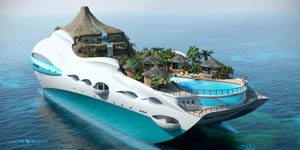
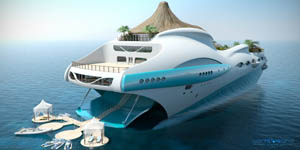
‘The Streets of Monaco’
‘The Streets of Monaco’ is our first design proposal. The theme is based around the Mediterranean principality with the primary focus being the famous grand prix circuit. The idea was to recreate the circuit as a fully functional kart track able to accommodate three karts side by side to allow for plenty of overtaking. By sizing the track in this way it has driven the overall dimensions of the yacht and the placement of the famous landmarks.
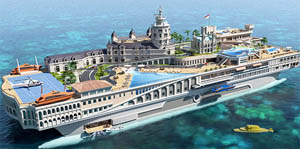


Recommended Book
The Fundamentals of Interior Architecture
By John Coles, Naomi House
This book offers an introduction to the key elements involved in the creation of aesthetically appealing and practically appropriate interior architecture. Each element, or fundamental, uses theory and contemporary and historical references to illustrate the richness and diversity of design practice. Using examples taken from work created by contemporary practitioners, The Fundamentals of Interior Architecture offers a unique insight into the principles and processes that underpin the work of the professional interior designer. The book contains five sections which together encapsulate the principle ideas, skills and knowledge that are employed in the creation of spatial solutions that support the needs of the client and which recognise the qualities of the building and its situation. Using illustrations and photographs these elements are identified and described in a way that makes them accessible to the reader.
The Indus Equation
By Strategic Foresight Group, Mumbai, India Introduction
Like most rivers in the world, the Indus River in South Asia does not recognize political boundaries. It crosses over Tibet, India, Pakistan and Afghanistan before finally emptying into the Arabian Sea at the foot of the Sindh province in Pakistan.
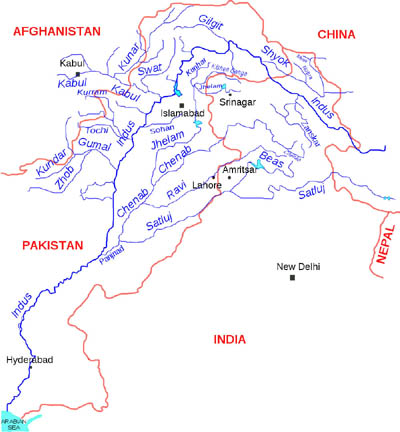
The two main benefactors of the Indus River waters are India and Pakistan. After partition in 1947 these waters formed a major cause of tension between the two countries. The headwaters of the river were situated in India while the body formed Pakistan’s main source of freshwater.
In 1948 an Inter-Dominion Accord was set up wherein India was obligated to release sufficient amounts of water to Pakistan for a nominal fee in order to meet the country’s immediate requirements. However, a more permanent solution was needed when tensions over water arose once again in 1951. While Kashmir – one of the more intractable issues between India and Pakistan – seemed far from a resolution, water provided a stepping stone upon which India and Pakistan could start a process of reconciliation. Nonetheless, reaching an understanding over the most optimum distribution of the Indus River Waters was no easy task. It took nine years of negotiations before India and Pakistan signed the Indus Water Treaty (IWT) in partnership with the World Bank and with financial assistance from the U.S. and U.K.
The IWT provides a mechanism for amicable water sharing between India and Pakistan, a luxury uncommon to many countries that have Transboundary Rivers. Since its ratification in 1960, India and Pakistan have not engaged in any water wars. Disagreements, disputes and the need for arbitration have arisen however they have been settled via legal procedures – provided for within the framework of the IWT – and not via armed conflict. The treaty is considered to be one of the most successful watersharing endeavours in the world today even though analysts acknowledge the need to update certain technical specifications and expand the scope of the document to include climate change.
As India and Pakistan stand at the threshold of yet another attempt to further cooperation, ‘water’ – as was the case in 1951 – can provide an impetus to tackle larger issues like Kashmir. There has been a lot of controversy and debate about the IWT, however, the core problems are minor in many cases and can be addressed with care through a process of negotiation.
The first section of this paper provides a comprehensive overview of Pakistan’s water situation; the second part discusses points of contention between India and Pakistan regarding the shared Western Rivers of the Indus and the conclusion provides the final analysis and recommendations that will assist water cooperation between these two nations in the future.
Overview of Pakistan’s Water Resources
Pakistan receives its water from 3 river basins – The Indus, Karan and Makran River Basins. Of these three, Pakistan is most dependent on the Indus River Basin as it covers 71% of its territory – comprising the whole of Punjab, Sindh, NWFP, PoK and the eastern parts of Balochistan – and provides water for 77% of the population. The Karan and the Makran originate along the plains of Balochistan and they cover only 15% and 14% of Pakistan’s territory respectively.
The Indus Basin has a large groundwater aquifer that covers 16.2 million ha (hectare). Groundwater is pumped with the help of tubewells, currently numbered at 0.9 million and 87% of these are run on diesel, making groundwater pumping impossible during Pakistan’s frequent periods of load shedding. Most urban and rural water is supplied from groundwater sources. Salt-water intrusion is a problem in Pakistan with about 36% of the groundwater classified as highly saline.
Average Annual Freshwater Availability, which accounts mainly for the Indus River Basin flow is pegged at 130MAF (million acre feet) but can reach as low as 116MAF per year. In 2008, total water withdrawal was estimated at 148.68MAF (183.4km3) creating a deficit of roughly 18MAF. Surface water withdrawal accounted for 98.74MAF (121.8km3) and groundwater withdrawal accounted for 49.94MAF (61.6km3). [It should be noted that withdrawal here refers mainly to the Indus Basin Irrigation System (IBIS) as withdrawal outside of this is negligible.]
Annual precipitation in Pakistan is roughly 500mm although this varies with less than 100mm in certain parts of Balochistan and Sindh and 1,500mm in the foothills and mountains of Punjab and NWFP. There is also an extreme variability in rainfall between the seasons. There are 2 main rainfall seasons in Pakistan – Rabi season (October-March) and Kharif Season (April-September).
60% of the annual rainfall is received during the peak of the Kharif season from July-September. Similar to the rainfall periods, 85% of the flow of the Indus is received during the Kharif Season (April to September) and the remaining 15% is received during the Rabi season (October to March). In addition, 80% of the water in the Kharif season is received from melt water.
[…]
Issues of Contentment
[…]
Need for a Comprehensive Water Agreement
The issue of the 12 dams is less about India’s development assistance program in Afghanistan and more about a joint-agreement between Pakistan and Afghanistan on the Kabul River. The two countries attempted to draft a water treaty in 2003 and then again in 2006 however the attempts failed on both occasions due to a number of reasons. As a result no institutionalized framework for cooperation on the Kabul River currently exists. A comprehensive water treaty between Afghanistan and Pakistan can help tremendously to address disagreements between the two countries about storage capacity and dam building.
Moreover, the IWT can be used as a model to inform the Af-Pak water treaty. Even though the IWT does not stand independent of limitations it is considered one of the most successful water treaties in the world, let alone the region, and it offers a better solution to water-sharing than the absence of any treaty at all. Due to Pakistan’s unique rights over the Kabul River, the IWT’s specifications concerning run-of-the-river dams as opposed to conventional dams can be used to a certain extent.
It is also important for India to be involved in Af-Pak water dialogues. Pakistan’s dissatisfaction over the interpretation of the IWT with regard to dam construction is often stated as an impediment to a subsequent Af-Pak agreement on the Kabul River. It may therefore be conducive to discuss Pakistan’s issues regarding dam-building with both countries present. As the lower riparian for all intensive purposes, Pakistan stands to gain a lot from a treaty.
Conclusions
The concluding remarks will summarize a few salient points from this report regarding Pakistan’s water situation as a whole, its approach to the IWT, water relations between India and Pakistan and lastly possible measures to improve these relations.
Pakistan’s water situation is not simply predicated on water flows from India. The low supply of water in Pakistan is largely due to water conveyance losses, poor infrastructure, increasing desalination, water pollution and climate change. Increased silting in the country’s dams has led to a decrease in Pakistan’s overall storage and hydel generation capacity. Certain biases at the centre, have led to inter-provincial disparities in water distribution. The lack of demand management measures has led to water wastage in the agricultural and domestic sectors. Even climate change and the retreating Himalayan glaciers have contributed to the water crisis in Pakistan. Often times India is blamed for all of these factors. It is true that the majority of Pakistan’s water resources flow from India, however, India has no control over Pakistan’s internal mismanagement of water resources or climatic conditions.
Pakistan’s fears about Indian manipulation of water resources are based less on facts and more on a “lower riparian anxiety complex”. Pakistan has recently been deemed a water scarce country (1,000m3/capita/year), it is struggling to cope with increasing water demand and in the midst of all this it does not want to deal with a further reduction in its water resources. As a result, Pakistan pushes the panic button every time India constructs a water development project in J&K. Its objections are purely emotive with no technical foundation. India has adhered to the IWT stipulations on water works in J&K for the past 50 years, constructing strictly run-of-the-river projects on the Chenab, Jhelum and the Indus Rivers, which it is permitted to do. India is well under the storage capacities set aside by the IWT for agricultural, power and incidental usage.
India has also been open to design changes, across the board, for all of its projects thus far. In the case of Baglihar, India engaged in consultations with Pakistan from 1999-2004 in order to address Pakistani concerns. In the case of the Wullar Barrage, India made major design changes in its 1991 draft and ultimately suspended construction, losing several crores of rupees, due to Pakistani objections. In the case of Kishanganga India is once again in the midst of finding a compromise in design and process that would be acceptable to both sides. All of these actions indicate that India is making an effort to address Pakistan’s concerns. However, these concerns should be valid otherwise they could seriously harm trust relations between the two countries and affect the integrity of the IWT.
Pakistani objections on small projects like Nimoo Bazgo, which are designed to generate an infinitesimal amount of power – 45MW as compared to the 969MW Neelam-Jhelum power plant – will not only erode trust and waste manpower and resources on both sides of the border, but this policy of blanket objections to all water projects will hinder development in J&K and PoK. In the case of the Tulbul project, Pakistan’s consent could assist development in both J&K as well as PoK and this would be in the true spirit of the future cooperation clause of the IWT, however Pakistan continues to take an alarmist view with regard to water.
Conspiracy theories on water, propagated by the Pakistani media, militant groups and even the political and military leadership on Indian “water aggression” will only encourage India to be more guarded in the dissemination of water related information. There is a clear agenda on the part of these establishments to propound a theory that the only way to gain complete control over Pakistan’s water resources is to gain a foothold over J&K. As long as this theory remains primary to the Pakistani agenda, India can never trust that Pakistan wants to use the IWT as a tool for cooperation rather than a tool to stall Indian water development in J&K.
Certain issues between India and Pakistan regarding dam filling and spillway gates must be addressed once and for all so that they do not arise again and again with each subsequent project. In addition, some of the basic principles of the IWT and even the current disagreements regarding its interpretation can be used to inform potential water agreements for other Transboundary Rivers in South Asia, case in point being the Kabul River in Afghanistan.
The Indus Water Treaty ranks as one of the most successful international treaties on water cooperation. However, because the treaty was designed in 1960 it does not provide for changes in water availability, increasing demands, environmental factors and technological advancements. These have all changed considerably since 1960 and there is a need to strengthen and extend the IWT, particularly its sections on future cooperation.
The expansion of the IWT could focus on an integrated development plan for the conservation of the Indus Basin. India and Pakistan can jointly set up an organization, with representatives from both countries, whose functions would entail identifying short term and long term supply capacity of the basin and its integrated development, creating techniques to mitigate and adapt to the effects of climate change and setting up infrastructure and coordinating the different technical agencies in both governments. Development of such a plan would require a vast amount of technical and financial resources, perhaps with the World Bank agencies playing a lead role.
This plan would involve a creative solution to engage in issues concerning Jammu and Kashmir. Cooperation on water will start the wheels turning on a larger Indo-Pak peace process without burdening it with an overtly political dimension. In the end, an integrated water development plan may appear to be utopian as it will require a physical and psychological paradigm shift which can be accomplished in the form of a complete end to hostilities and a change in the way we approach the issue of water sharing. However, there is no alternative to such bold thinking if India and Pakistan want to build a future based on trust, cooperation and a genuine commitment to the social and economic development of the millions of poor in both countries.
You can download the full report lick here
Enduring Legacies: Slavery, Serfdom and Prison in America, Europe and Russia

Dimitri Devyatkin, a video-filmmaker and writer, grew up in New York. He studied documentary film directing in Russia, produced prize winning documentaries that were broadcast in the US and Europe, also worked for CBS News, ABC and others.
Summary: The US, Europe and Russia are deeply affected by the legacies of coerced labor – slavery and serfdom, incarceration and concentration camps, not boding well for the future. Who benefits?
A giant arc starts from the earliest days in Europe with the Renaissance, the Enlightenment and the Reformation. Great shifts occurred as large groups left their own land and went to work for others.
Previously, people in pre-industrial, medieval times worked slower without technology but provided for themselves in fewer hours than today, leaving more time for arts, dancing, religion and socializing.
As new geographic areas opened for possible exploitation, the great need for manual workers could only be filled using coercive means and earned great profits. These forms of coercion — slavery, serfdom, prison and bonded labor — are precursors of the concentration camp, the Gulag, today’s prison-industrial-police complex, the modern ghetto and mind control through the media.
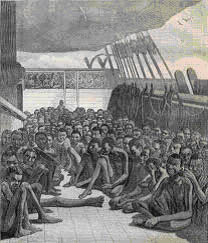
Under slavery, the slave owner beats the slave to make him work. The employer cannot beat a free laborer, but instead waits for the worker to be hungry, so he accepts working for low pay — earning profit for the employer.
These “Enduring Legacies” of coerced labor are raw, unhealed scars, still rampant in our world today. In the US, the system of chattel slavery was the ugliest manifestation. In Russia, peasant serfdom ran almost parallel, with long-term effects to this day. Europe benefited greatly from slavery – the slave trade was the basis of the Industrial Revolution.
Today, Europe offers different solutions and experiences. For example, prisons in Norway are more humane than in either Russia or the US, while Germany offers convicted violators systems of punishment negotiation with the victims of their crimes.
The future is frightening in regard to coming ways of coercion or Big Brother social control. In prisons of the future, high technology may tip the advantage to the jailer in imposing inhuman conditions, such as surgically implanted zappers and electronic disabling armbands.
Will these technological fixes make a difference in maintaining the obscene imbalance of wealth vs poverty? In the last 20 years, the growth of income for the top .01% of America, the top 400 families, has been stupendous in the many trillions of dollars. The top 1% of Americans own 40% of the country’s wealth. The system perpetuates an inequality that is even greater than the days of the Pharaoh or any previous empire.
How long do people accept working so much more than necessary for the sake of a rich boss or investor? The work provided is worth more than is paid for it – maybe 25% more – “surplus value” – the source of profits for the wealthy. If workers benefit from the system themselves, they accept it. A small parasite is tolerated if it does not eat too much. But if the parasite gets big and demands more, it becomes a problem.
As long as there is injustice and high unemployment, unfair distribution of essential resources in the face of conspicuous consumption, there will be struggle. It cannot be suppressed but must be ameliorated. Looters and rioters are ugly symptoms bred by inhuman social conditions. Instead of police and military suppression, people need jobs to feed their families. Only a program of widespread government employment can solve the financial mess. Work has to be dignified, respectful and humane. A person who works every day at an enterprise becomes just as invested in that enterprise, as a Mercedes-driving executive who comes in once a week to collect the earnings.
The bank used to be a normal community service, like the post office, the doctor and the grocery store. Now they’re all Big Box mammoth enterprises. Small businesses are driven out and the banks are all labeled Chase. On nearly every block of downtown Manhattan, you see former small banks changed to Chase, and the brash young bankers, their loafers up on their desks, relaxing. Somebody seems to have benefited from the 2008 financial collapse: “Big fish eat the little fish.”

A little rebellion now and then is a good thing, as necessary in the political world as storms in the physical, medicine for sound health of government. … The aristocracy of our moneyed corporations already dares to challenge our government to a trial of strength and bid defiance to the laws of our country.
Thomas Jefferson We still accept mind sets of the old social structure based on slavery. We are the United States of slave owners and moneylenders. The same struggle for which so many fought and died in the American, the French and the Russian Revolutions, is still in effect today – the struggle for liberty and justice, for rights of men and women, to work for fair pay, for representation in their government. Why are the rights of bankers and investors supreme over everyone else? Why can’t we all have free medical care, free public transportation, free telephone, TV, media, free education, free childcare, low priced housing, healthy food, social services?
Are we not good enough? Can have a just society in the future?
Because our society today is so corrupt and so deeply controlled by criminal parasites, before we can attempt any serious change, we must be ready for a virulent counter attack. We cannot beat them with bullets against bullets. We can have contact with people’s minds and souls. There are surely more good people than monsters and killers.
I – History/Roots
A. Rise of Slavery and Serfdom as systems: Slavery before 1492 was not based on race. White-skinned blue-eyed Slavs were enslaved by the Romans. Some former slaves reached greatness, e.g. Aesop, a few could acquire their own freedom, and the status of being a slave was not necessarily inherited.
The rise of chattel slavery in America and serfdom in Russia were stages in the growth of capitalism in both countries – forms of super exploitation.
Africans had visited the Western Hemisphere long before Columbus, riding strong transatlantic currents between Mali and Brazil. Large stone heads with African features are testimony to pre-Colombian Africans having visited Brazil. Africa had highly developed societies, where centuries’ old cultures and rich universities stood, astronomy and surgery were practiced. They had not developed metal weaponry, so when confronted by Europeans, they collapsed.
Chattel slavery of Africans in America began under Columbus. He was convinced that he had discovered a new route to India. When the so-called “Indians” – Native Americans his men had enslaved ran away or died, Columbus returned to Europe determined to bring enslaved Africans skilled at producing sugar and rice and mining gold, work which Europeans could not perform in such brutal conditions.
“Slav” means slave in Latin; Slavs from Eastern Europe were slaves to the Romans. Slavs were ethnically native to Russia, as were the noblemen who owned them. In old Russia, serfs “came with the land,” so they were not usually bought and sold separately. Land had originally been distributed by the Tsar to the nobles, whose only obligation in return was military service, the serfs as foot soldiers, the nobles as officers. This efficient system has led to Russia occupying one sixth the land surface of the globe. Estates in Russia held far more slaves than the American plantations held enslaved Africans.
Whole societies of Africans were uprooted by the Atlantic slave trade, as if they were livestock, and transplanted violently in the genocidal “Middle Passage,” triangular sea trade. After selling their sugar in Europe, slave traders bought enslaved Africans, which were transported to be sold in the Americas. The high mortality on board the slave ships richly nourished the sharks of the Atlantic Ocean, a furious process of selection by which only the strong survived. This may have favored people with the sickle cell trait in their blood, as a survival mechanism in horrific conditions, but which led to increased sickle cell anemia in generations of the blacks who survived. Which European countries especially benefited from the slave trade? For example, what was the basis of the Netherlands’ “Special Relationship” with the United States?
In the gigantic open land empires of America and Russia, labor was sorely needed. Free laborers were not reliable, and forced labor was seen as an acceptable way to assure a sufficient supply of workers especially in the highly profitable agricultural enterprises of the American South and the Russian breadbasket heartland.
B. Slavery in the American Revolution
Besides the famous declarations in Boston of “No Taxation without Representation,” the American Revolution was largely controlled by Southern slave owners, who were concerned about preserving their “property,” which meant slaves. England seemed ready to ban slavery in 1772. In a case reported widely on both sides of the Atlantic, James Somerset, a slave who’d been brought to England by his master, was declared free by a British judge, effective upon having set foot on British soil. Was continuation of the “abominable practice” possibly a stimulus for Revolution among America’s slave owning elite? John Adams of Massachusetts and Thomas Jefferson of Virginia made compromises with the Southern slave owners. New York and Brooklyn in particular were heavily dependent on slavery.
Virginia’s British Governor Lord Dunmore declared slaves free if they could reach British lines. More blacks died during the war than whites, mostly of smallpox and starvation. Thousands left the plantations, but most were either re-enslaved or died.
C. In the new USA, enslaved Africans, about 20% of the population, could not vote, but they were counted for taxation purposes in the Constitution as 3/5ths of a person, a boon when counted as a constituent for the purpose of Congressional representation. US federal power served to guarantee and perpetuate slavery. James Madison, principal writer of the Constitution, was particularly concerned with slave revolts, having lost his grandparents in such a rebellion. Several states joined the Union for reasons directly associated with slavery – e.g. Florida was admitted as a slave state so owners could chase after their runaway slaves, called “Maroons,” from Georgia.
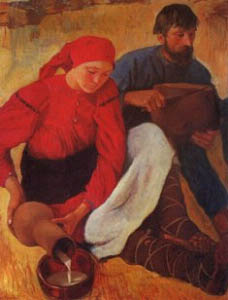
D. In Russia, with over 80% of the population serfs, the entire economy was structured on the system of forced labor. In Russia, military service of the serfs was provided to the State free of charge by their owners, creating a stable, long-lasting, hierarchical social order. Slaves were never more than one fifth of the total American population, and only exceeded the population of whites in a few Southern states, like South Carolina and Virginia. Most slaves in America lived on smaller plantations, with between 20-100 individuals. Russian serfs lived on vast estates with hundreds or thousands of inhabitants. Some estates had tens of thousands of serfs, and absentee owners were the norm.
E. Building Empires on the backs of slaves and serfs
The expansion Westward in North America – the second “Middle Passage,” and the Russian move to the Far Eastern Siberia were both built on captive labor. Serf and slave rebellions were brutally suppressed and the historical evidence is still missing in the histories of both countries.
Slavery and serfdom represented tremendous profit sources for the owners, in both America and Russia. Slave and serf-owning classes controlled their societies, and imposed their ways on the governments. Profits earned from the slave trade provided the starting capital that built Manchester, Bristol and Liverpool, and launched the industrial revolution in Britain in the 17th and 18th centuries. Decisions made at certain possible turning points led to huge differences, such as Jefferson and Adams accepting the onerous terms of the slave owners.
Slavery in the Protestant United States differed from slavery in Catholic Latin and South America, where there was more intermarriage and actual integration of Black, native American and whites. Latin American culture accepts more integration than North American, where black music, life-style, humor, even language, is markedly divided from white. There were more slave rebellions in Latin America than in the North.
The tremendous power and wealth generated by slavery in America and serfdom in Russia explains why the owners insisted for so long on maintaining the “Peculiar Institution” – of owning other human beings.
II — Abolitionism, Emancipation, Integration, Jim Crow, Civil Rights, Ghettos
A. Tsar Alexander freed the serfs in 1861, but the act was not enforced, so there was little change in society. After the serfs were “freed,” there was little immediate change but many peasants lost their farm workplaces, and migrated to cities and industrial areas. Russia became an industrial giant in the 1880s with a steady flow of cheap wage labor.
B. The North’s Civil War victory was due, in part, to more effective social management, the advantages of wage-earning workers in place of a chattel system that enabled a fast-growing early-industrial society in the North, compared to the South. Lincoln was the only president until Kennedy (tried) to use the government’s Constitutional power to print actual “Greenback” US Dollars issued by the US Treasury. No other President has done so since. He openly chose to pursue the war for monetary reasons, not for the principle of freeing the slaves. (The Emancipation Proclamation of 1863 only applied to slaves held in rebel territories, so slaves in other states had to wait until the 13th Amendment to the Constitution to be freed.) Lincoln’s assassination was fomented by agents, who it seems, were hired by European banking interests. The Union Army enforced the Emancipation of slaves in the South, making it a reality. However, the brief period of progress in the Reconstruction period was soon rescinded and the harsh Jim Crow post-slavery variant set in.
Lynching became more common in former slave states after Emancipation. Slave owners before 1863 were reluctant to destroy their slaves for financial reasons. Capital punishment is a direct extension of lynching; both forms of revenge rationalized as a “deterrent” or an example for other possible felons.Albert Einstein and Paul Robeson were good friends in Princeton, NJ, and they worked together publicly against lynching, which was especially rampant in the South after World War II. Lynching became more prevalent as some Blacks returning triumphantly after fighting the Nazis were considered uppity and “had to be taught a lesson.” In 1947 Einstein and Robeson wrote a piece on lynching for the New York Times Op Ed page but it was refused for publication.
C.Prison became an extension of slavery in America and serfdom in Russia. The same overseers and the exact same methods from former plantations morphed into the South’s criminal justice system.Professor Loïc Wacquant, UC Berkeley: “Several ‘peculiar institutions’ have operated to define, confine, and control African-Americans… slavery, Jim Crow racism, the ghetto.” We now have “the novel institutional complex formed by the remnant of the dark ghetto and the carceral apparatus – the super ghetto, the prison system.”
US – lead incarcerator in the world:
The US has 1/20th of the world’s population, and 1/4 of the world’s prisoners. For black males, 1 in 15 is behind bars.
With 2.4 million people in prison, the US now surpasses Russia with the world’s highest percentage of population behind bars: one in 99 Americans.

The US is currently world leader in prisons. But until the collapse of Soviet power, the world leadership in incarceration was the USSR. In the 20th century millions of Soviet citizens were imprisoned and millions died in the Gulag. Alexander Solzhenitsyn in “Gulag Archipelago” wrote that Stalin’s advisors recommended a dual-purpose policy:
1) Round up masses of outspoken peasants on accusations they are “anti-Soviet”,
2) Use them as free labor to build the new societyGiant construction projects, the Moscow and White Sea Canals, vast apartment complexes and factories still in use today were built by slave prison laborers – “zeks” – in the 1930s.
III – Long term effects
We are descendants of slave/serf societies and it shows in our mind-sets, our ways of life and forms of employment. We’ve inherited a high rate of violence in society, and we use incarceration and police violence to settle socially caused deviations. We keep trying to solve problems by locking people up. Future trends may be frightening. Dr. Joy DeGruy Lear, Portland State University, Post-Traumatic Slave Syndrome, has pioneered a theory – Enslaved people suffered trauma from the horrors of slavery; a disorder passed down from one generation to the next. The trauma is now exhibited in slave descendants as “adaptive behaviors” – obstacles to progress in the African American community.Did the natural selection of the brutal “Middle Passage” and the daily horrors of outright slavery, make Black people even more survival oriented? Until the breakdown of the Black church and matriarchal society, Blacks had a much lower suicide rate than the general population – but now it has risen to the society norm. Black America, were it a nation by itself, would be the 10th largest economy in the world. Blacks are 12% of the U.S. population and they spend over $100 billion a year as consumers and taxpayers.
The Future: New technological means of coercion – “Cattle-prod” internal zapper chips have recently been patented that can be implanted surgically, even without a recipient’s assent, and can be triggered from a distance to punish the person. The chips can be inlaid in such a way that scar tissue grows over them, making them removable only through deep surgery.
Another variant patented uses an arm-band with a needle turned in against the wearer. Tampering with the arm-band sets off a zapper with a knock-out drug injected to the person. Professor Nils Christie, Professor of Criminology at the University of Oslo, Norway, has done comparisons of different countries’ rates of incarceration, length of prison terms sentenced for the same crimes, length of actual time served, demands for parole and release, and rates of recidivism. The US and Russia rank among the world’s highest in all categories. The Scandinavian countries are some of the lowest. Why?What factors make societies like ours so concerned with dealing out harsh punishments to citizens who disobey the rules? CIA torture techniques, black sites, detention prisons and extraordinary renditions are the new forms of these same forces.
Until just over a hundred years ago, there were despicable exhibitions of live human beings – Human Zoos. As late as 1899, Zurich, Basel, many other European and American cities had places where throngs of people would be entertained by viewing caged human beings from Africa perform all life functions under the glare of spectators.
Several Eskimos were brought back to New York by Robert Perry in the early 1900s. They were housed in the top floor of the American Museum of Natural History. When an elderly Eskimo gentleman died, his son was consoled with a funeral and fake burial in New York, but later the son was horrified to see his own father’s body stuffed and mounted in an exhibit in the museum.
Are we going backwards as a society? Will we return to these horrible times of slavery and coercion or are today’s versions – wage slavery, prisons and unemployed masses – more enforceable, higher profit and more efficient?
Futurist Portrait: Dave Evans

Dave Evans, Chief Futurist, Cisco Innovations Practice Internet Business Solutions Group
A Cisco veteran of more than 21 years, Evans joined IBSG from IT, where he most recently managed the global architecture innovations team, focusing on IP telephony, unified messaging, wireless, networked home, and Internet-related technologies.
Evans has a passion for applying technology innovation to real business needs. He is also respected outside Cisco as an expert in emerging technologies and has numerous relationships with thought leaders, including those in the venture capital community.
Evans has garnered numerous awards and recognitions throughout his Cisco career, including the CEO’s “Unsung Hero” award, which he has received twice, and numerous other awards for technology innovation and teaming.
Prior to Cisco, Evans held varied IT positions at both AMD and MMI. Evans has pursued computer science and computer engineering at San Jose University in San Jose, California.
Agenda

| NEW Season Events 2011/2012 October 13, 2011 the future of the Living Room Experience interior design Location: Museum Geelvinck, Keizersgracht 633, 1017 DS Amsterdam  November 3, 2011 the future of the Future Utopia versus The End Of The World As We Know It Location: VKG, Wibautstraat 150, 1091 GR Amsterdam January 2012 the future of Film February 2012 the future of Social Biomimicry March 29, 2012 the future of Languages Location: Amsterdam April 2012 the future of Germany May 2012 the future of Taxes June 2012 the future of Urban Energy |

The Breakfast Club will soon announce the next events!
Credentials
Felix Bopp, Editor-in-Chief
Raphaelle Beguinel, Assistant Editor





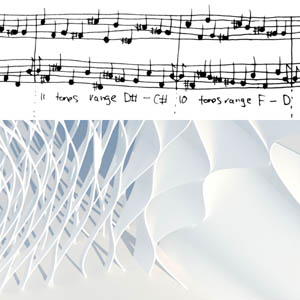
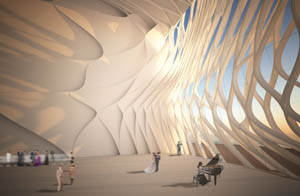
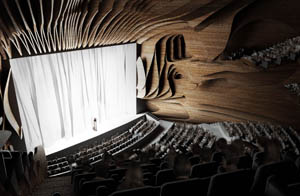
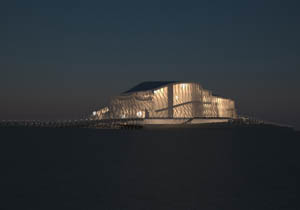

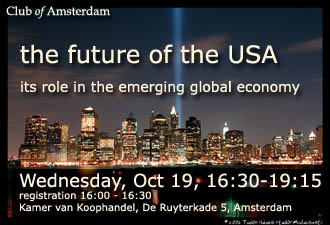



Customer Reviews
Thanks for submitting your comment!